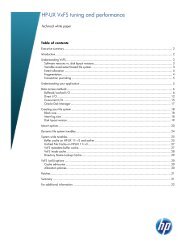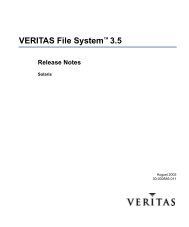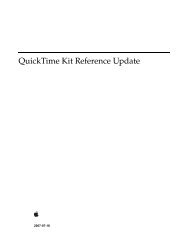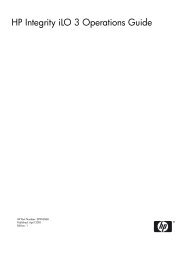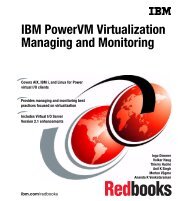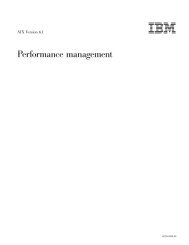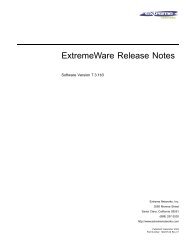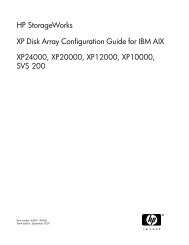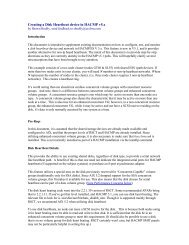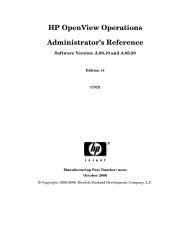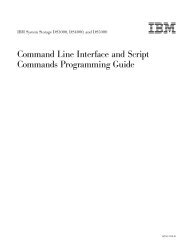QuickTime Kit Programming Guide - filibeto.org
QuickTime Kit Programming Guide - filibeto.org
QuickTime Kit Programming Guide - filibeto.org
You also want an ePaper? Increase the reach of your titles
YUMPU automatically turns print PDFs into web optimized ePapers that Google loves.
C H A P T E R 1<br />
The <strong>QuickTime</strong> <strong>Kit</strong> API<br />
The <strong>QuickTime</strong> <strong>Kit</strong> framework was developed by Apple to provide support for the most common<br />
media-related needs of Cocoa developers. This support was accomplished by using certain abstractions<br />
and data types familiar to Cocoa programmers and by defining other abstractions and data types that<br />
are new––but only where necessary. This chapter describes the various Objective-C classes and<br />
methods implemented with <strong>QuickTime</strong> that make up the <strong>QuickTime</strong> <strong>Kit</strong> framework and discusses<br />
some of their features and possible uses.<br />
You’ll want to read this chapter, which is brief, for an overview of the <strong>QuickTime</strong> <strong>Kit</strong> classes and<br />
functions. For more detailed information, refer to <strong>QuickTime</strong> <strong>Kit</strong> Framework Reference.<br />
If you want to see the framework header files, you can find them in the Mac OS X<br />
/System/Library/Frameworks directory as QT<strong>Kit</strong>.framework. The new <strong>QuickTime</strong> palette resides<br />
in the /Developer/Extras/Palettes directory as QT<strong>Kit</strong>.palette.<br />
In the next chapter, you’ll work with the new QT<strong>Kit</strong> palette and explore its capabilities in building a<br />
simple QT<strong>Kit</strong>Player application.<br />
Working With the <strong>QuickTime</strong> <strong>Kit</strong> API<br />
The <strong>QuickTime</strong> <strong>Kit</strong> is an Objective-C API designed for the basic manipulation of media, including<br />
movie playback, editing, and import and export to standard media formats.<br />
The framework is at once powerful, yet easy to use in your Cocoa application. The QT<strong>Kit</strong> palette<br />
provided in Interface Builder, for example, lets you simply drag a <strong>QuickTime</strong> movie object, complete<br />
with a controller for playback, into a window, and then set attributes for the movie––all of this without<br />
writing a single line of code.<br />
Notably, the <strong>QuickTime</strong> <strong>Kit</strong> provides Objective-C classes that are suitable for use within a wide range<br />
of Cocoa-based software, including applications with a GUI and tools intended to run in a “headless”<br />
environment. For example, you can use the <strong>QuickTime</strong> <strong>Kit</strong> framework to write command-line tools<br />
that manipulate <strong>QuickTime</strong> movie files.<br />
One distinct advantage in working with the <strong>QuickTime</strong> <strong>Kit</strong> framework is that it does not require, in<br />
most cases, a thorough knowledge of the <strong>QuickTime</strong> C API, which can be in itself something of a<br />
daunting task. (The <strong>QuickTime</strong> C API contains over 2500 function calls and although those calls are<br />
documented, developers who are new to <strong>QuickTime</strong> may find the API more than a bit overwhelming.)<br />
Nor does it require an understanding of the fundamentals of Carbon, including but not limited to<br />
QuickDraw, the File Manager, and the Memory Manager.<br />
Working With the <strong>QuickTime</strong> <strong>Kit</strong> API 11<br />
2005-11-09 | © 2004, 2005 Apple Computer, Inc. All Rights Reserved.



